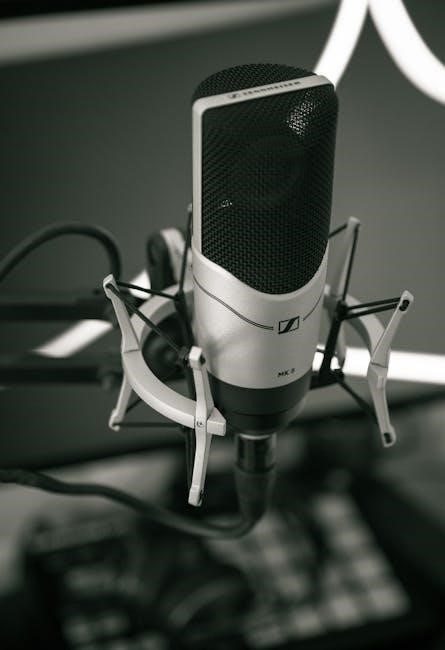Baofeng radios are affordable, versatile, and popular communication devices for amateur radio enthusiasts and professionals. Known for their durability and ease of use, these radios offer a wide range of features, including dual-band operation and customizable settings. Whether for emergency communication, outdoor activities, or professional use, Baofeng radios provide reliable connectivity and flexibility, making them a favorite among users worldwide.
1.1 Key Features of Baofeng Radios
Baofeng radios offer a combination of affordability, durability, and advanced features, making them popular for amateur and professional use. Key features include dual-band operation, long-lasting batteries, and a rugged design. They support programmable channels, multiple power settings, and compatibility with external accessories. The radios also provide clear audio quality, intuitive controls, and customizable settings, ensuring versatility for various communication needs. Their ease of use and robust performance make them ideal for both beginners and experienced users in different environments.
1.2 History and Evolution of Baofeng Radios
Baofeng radios, developed by the Chinese company Baojing Electronics, have become a staple in amateur radio communication since their introduction. Known for their affordability and reliability, Baofeng radios gained popularity worldwide for their versatility in both hobbyist and professional settings. Over the years, the brand has introduced various models, each offering improved features and capabilities. From the iconic UV-5R to the UV-82, Baofeng has consistently innovated, ensuring their radios remain accessible and effective for a wide range of communication needs.
1.3 Importance of Baofeng Radios in Communication
Baofeng radios play a crucial role in modern communication, offering reliable and cost-effective solutions for amateur radio enthusiasts, emergency responders, and professionals. Their versatility allows users to stay connected in diverse settings, from outdoor adventures to critical emergency situations. The radios’ ability to support multiple frequencies and modes ensures widespread compatibility, making them indispensable tools for building and maintaining communication networks. Their affordability and durability have made Baofeng radios a cornerstone in both personal and professional communication strategies worldwide.

Preparation Before Programming Your Baofeng Radio
Before programming, ensure your computer meets system requirements, download necessary software, and gather required equipment like a programming cable for a smooth setup process.
2.1 Computer System Requirements
To program your Baofeng radio, ensure your computer runs a compatible operating system like Windows 98, ME, XP, Vista, 7, 8, or 10. macOS users must use specific software versions. Install the latest USB drivers and ensure your system has at least 2GB of RAM for smooth operation. A USB port is necessary for connecting the programming cable. Verify these requirements before proceeding to avoid compatibility issues during the programming process.
2.2 Necessary Software for Programming
To program your Baofeng radio, you’ll need specific software. CHIRP is a popular choice for its user-friendly interface and compatibility with various Baofeng models. Additionally, Baofeng’s native programming software, such as the UV-B5_520MSetup_v1.09.exe, is essential for certain models. Ensure you download the correct version of CHIRP or native software for your radio model. Install the software and required drivers to enable communication between your radio and computer. Always download software from trusted sources to avoid malware or compatibility issues.
2.3 Required Equipment for Programming
Programming your Baofeng radio requires specific equipment. A compatible programming cable is essential, ensuring data transfer between the radio and computer. Choose a cable with the correct connector for your Baofeng model. A computer with a USB port and a supported operating system (e.g., Windows) is necessary. Additionally, drivers for the cable must be installed. For optimal performance, consider using an external antenna and ensure the radio is fully charged or connected to a power source. Avoid using cheap, incompatible cables to prevent connectivity issues.

Manual Programming Without a Computer
Manual programming allows you to configure your Baofeng radio directly using its keypad. This method is handy for field adjustments without a computer. Use menu settings to set frequencies, tones, and other parameters, ensuring accurate configuration for reliable communication. Follow step-by-step instructions carefully to avoid errors.
3.1 Step-by-Step Instructions for Manual Programming
Power on the radio and press the VFO/MR button to enter Frequency Mode. Use the keypad to input the desired frequency.
Press A/B to select the A Side (upper display) for programming.
Navigate to the Menu by pressing the Menu button, then use the arrow keys to select Channel Settings.
Choose an empty channel, input the frequency, and set additional parameters like tone squelch.
Press Menu again to save the configuration.
Repeat for other channels as needed. This method ensures quick setup without a computer.
3.2 Common Challenges in Manual Programming
Manual programming of Baofeng radios can be tricky due to complex menu navigation and frequency input errors. Users often struggle with saving configurations correctly and may encounter issues with tone squelch settings. Incorrect channel organization and misalignment of RX/TX frequencies are also common problems. Additionally, the small keypad and lack of visual feedback can lead to mistakes. These challenges highlight the importance of following step-by-step instructions carefully and double-checking settings before finalizing.
3.3 Solutions to Manual Programming Issues
To resolve manual programming challenges, use detailed step-by-step guides and double-check frequency inputs. Ensure RX and TX frequencies align, and verify tone squelch settings match your needs. Regularly save configurations to avoid data loss. If issues persist, reset the radio to factory settings or consult online resources for troubleshooting. Practicing with a backup device can also help build confidence and reduce errors during the manual programming process.

Using Programming Software
Using programming software simplifies setup and customization of Baofeng radios. Tools like CHIRP and Baofeng’s native software allow easy import of frequency lists and backup of settings, ensuring efficient configuration.
4.1 Downloading and Installing Programming Software
Download and install programming software like CHIRP or Baofeng’s native software from trusted sources. Ensure compatibility with your radio model and operating system. Install drivers for the programming cable to establish a connection. Follow on-screen instructions for installation. These tools enable easy import of frequency lists, customization of settings, and backup of configurations, streamlining the programming process for optimal radio performance.
4.2 Step-by-Step Guide to Using CHIRP Software
Download and install CHIRP software from its official website. Connect your Baofeng radio to the computer using a compatible programming cable. Open CHIRP and select your radio model from the list. Import frequency lists or manually enter channels, setting parameters like mode, tone, and offset. Use the “Memories” tab to organize channels into memory slots. After configuring, upload the settings to your radio by clicking “Write to Radio.” This ensures all channels and settings are correctly programmed for optimal performance.
4.3 Using Native Baofeng Programming Software
Native Baofeng programming software, specific to your radio model, offers tailored features for precise customization. Download the correct version from trusted sources to ensure compatibility. Install the software and connect your radio using a programming cable. The interface allows you to edit channels, set frequencies, and configure advanced options like squelch and tones. Upload your settings to the radio for seamless operation. This method ensures optimal performance and compatibility, though it may require updating drivers and can be less user-friendly for beginners compared to CHIRP.

Choosing the Right Baofeng Model
Selecting the ideal Baofeng model depends on your needs. The UV-5R is a great all-around choice, while the UV-82 offers more advanced features for specific use cases. Consider build quality, additional features, and intended use to make the best decision for reliable communication.
5.1 Baofeng UV-5R vs. UV-82: Key Differences
The Baofeng UV-5R and UV-82 are popular models, but they cater to different needs. The UV-5R is compact, lightweight, and budget-friendly, making it ideal for casual users. In contrast, the UV-82 offers a larger display, better audio quality, and a full keypad for easier programming. Both models support dual-band operation and similar frequency ranges, but the UV-82 is more durable and suitable for professional or heavy use. Choosing between them depends on your preference for portability versus advanced functionality.
5.2 Baofeng UV-9R: Features and Capabilities
The Baofeng UV-9R is a high-performance dual-band radio offering enhanced features like a color LCD display, increased power output, and improved reception. It supports VHF and UHF frequencies, with programmable channels and customizable settings. The UV-9R also includes a built-in flashlight, long-lasting battery, and compatibility with external accessories. Its robust design and advanced functionality make it suitable for both amateur and professional users, ensuring reliable communication in various environments and scenarios.
5.3 Selecting the Best Model for Your Needs
Choosing the right Baofeng model depends on your specific communication needs. Consider factors like frequency range, power output, and additional features. For basic use, the UV-5R is ideal due to its portability and essential functions. For outdoor or professional use, the UV-82 offers higher power and durability. Assess whether you need dual-band capability, water resistance, or advanced features like DTMF tones. Match the radio’s capabilities to your environment and communication goals for optimal performance and satisfaction.

Setting Up and Using the Radio
Setting up your Baofeng radio involves configuring basic controls, managing power settings, and optimizing antenna usage. Start by familiarizing yourself with the interface and essential functions to ensure smooth operation.
6.1 Understanding the Basic Controls and Functions
The Baofeng radio features an intuitive interface with controls for volume, power, and frequency selection. The VFO/MR button toggles between frequency and channel modes, while the A/B button switches between the upper and lower displays. The PTT button activates the transmitter for voice communication. Menu navigation is managed through the arrow keys, allowing users to adjust settings like squelch, tone, and power levels. Understanding these controls is essential for effective operation and customization of your Baofeng radio.
6.2 Configuring Common Settings
Configuring common settings on your Baofeng radio enhances functionality and personalization. Start by accessing the menu using the arrow keys. Adjust the squelch level to reduce background noise and ensure clear communication. Set the power levels to balance range and battery life. Enable tone squelch to filter signals and reduce interference. Customize the display settings for better visibility, and configure the scan function to monitor multiple channels. These adjustments ensure optimal performance tailored to your communication needs.
6.3 Using Scanning and Channel Organization
Scanning and channel organization are essential for efficient communication. Enable scanning to automatically search for active channels, ensuring you don’t miss important transmissions. Use the VFO/MR button to toggle between frequency and channel modes. Organize channels into groups or priority lists to quickly access frequently used frequencies. Set priority channels to monitor critical communications without interruption. This feature enhances monitoring efficiency and streamlines your communication workflow, making it ideal for both casual and professional use.

Optimizing Performance
Enhance your Baofeng radio’s performance with a high-quality antenna for improved reception. Manage battery life by adjusting power settings and using energy-saving modes. Utilize external accessories like speakers and microphones for better functionality.
7.1 Choosing the Right Antenna for Better Reception
Selecting the right antenna significantly impacts your Baofeng radio’s performance. A high-gain antenna improves signal strength and range, reducing interference. For portability, the Nagoya NA-771R is a popular choice, while the Tram 1185 offers excellent durability for outdoor use. Consider the frequency range and impedance (50 ohms for Baofeng radios) when choosing. A properly matched antenna ensures optimal transmission and reception, enhancing overall communication effectiveness in various environments.
7.2 Managing Battery Life and Power Settings
Maximizing battery life on your Baofeng radio involves adjusting power settings and usage habits. Lowering the transmit power when possible conserves energy, while enabling power-saving modes reduces standby consumption. Avoid unnecessary backlight and flashlight use to extend battery life. Regularly charging the battery and using genuine Baofeng accessories ensures optimal performance. Monitoring battery levels and storing the radio properly when not in use further enhances longevity, ensuring reliable communication in critical situations.
7.3 Using External Accessories for Enhanced Functionality
External accessories can significantly enhance your Baofeng radio’s performance and versatility. High-gain antennas improve reception and transmission range, while external speakers or headsets ensure clear audio in noisy environments. Programming cables and software enable advanced customization, allowing you to fine-tune settings and update firmware. Additional battery packs and chargers provide extended operation, and protective cases safeguard your radio from damage. These accessories not only boost functionality but also tailor the radio to meet specific communication needs, ensuring optimal performance in various scenarios.

Advanced Features and Customization
Baofeng radios offer advanced customization options, such as display personalization, DTMF tone setup, and memory management. These features allow users to tailor their radios for specific needs and preferences.
8.1 Customizing the Radio’s Display and Settings
Customizing your Baofeng radio’s display and settings allows for a personalized user experience. Users can adjust brightness, contrast, and backlight settings for optimal visibility. The display mode can be toggled between frequency and channel names, while the menu offers options to customize fonts and colors. Additionally, keypad tones, VOX sensitivity, and scan settings can be tailored to individual preferences. These customization options enhance functionality and user satisfaction, making the radio more intuitive and adaptable to specific communication needs.
8.2 Setting Up DTMF and Tone Squelch
Setting up DTMF and tone squelch on your Baofeng radio enhances communication clarity and reduces interference. DTMF tones enable remote access to repeaters and special features, while tone squelch filters unwanted signals. To configure, navigate to the menu, enable DTMF mode, and assign specific tones to channels. Adjust sensitivity levels to ensure clear transmission and reception. Proper setup ensures seamless communication, minimizing background noise and optimizing your radio’s performance for reliable operation in various environments.
8.3 Memory Management and Channel Organization
Efficient memory management and channel organization are crucial for optimal Baofeng radio performance; Users can store up to 128 channels, organizing them into zones for easy access. Assign clear labels to channels for quick identification. Regularly review and update stored frequencies to ensure relevance; Use scanning features to monitor multiple channels simultaneously. Proper organization enhances communication efficiency, especially in dynamic environments. Backup your settings periodically to avoid data loss and maintain seamless operation across all programmed channels.

Emergency and Survival Strategies
Baofeng radios are essential for emergency communication, offering reliable connectivity during disasters. Create an emergency plan, including predefined channels and backup power sources. Portable kits with antennas and batteries ensure readiness. Stay connected and informed when traditional networks fail, making Baofeng radios a vital tool for survival situations.
9.1 Using Baofeng Radios in Emergency Situations
Baofeng radios are indispensable in emergencies, providing reliable communication when traditional networks fail. Their portability and dual-band functionality allow for quick access to help. Preprogrammed channels for emergency frequencies ensure rapid connectivity; Built-in flashlights and long battery life enhance usability in the field. With a durable design, Baofeng radios withstand harsh conditions, making them a critical tool for rescue operations, natural disasters, and survival scenarios where immediate communication is vital.
9.2 Setting Up an Emergency Communication Plan
Creating an emergency communication plan with Baofeng radios involves designating specific frequencies for group members. Assign clear roles and ensure all radios are programmed with the same channels. Include a primary and secondary frequency for redundancy. Establish a communication protocol, such as regular check-ins and emergency codes. Test the plan in advance to ensure reliability and make adjustments as needed. Store backup power sources and spare radios in an easily accessible location to maintain connectivity during crises.
9.3 Building a Portable Emergency Radio Kit
A portable emergency radio kit should include a Baofeng radio, high-capacity battery, solar charger, and a durable antenna for improved reception. Pack essential accessories like a PTT switch, speaker microphone, and programming cable. Store everything in a rugged, water-resistant case with compartments for organization. Add a first-aid kit, flashlight, and extra supplies to ensure readiness. This kit ensures reliable communication and adaptability in crisis situations, helping you stay connected when it matters most.

Troubleshooting Common Issues
Troubleshooting Baofeng radios involves addressing common programming errors, connectivity problems, and firmware issues. Understanding these challenges helps users resolve issues efficiently, ensuring reliable communication in all situations.
10.1 Common Programming Errors and Solutions
Common programming errors include incorrect frequency input, mismatched tone squelch settings, and forgotten channel saves. Solutions involve double-checking settings, using programming software like CHIRP for accuracy, and ensuring the radio is in VFO mode before saving. Regular testing after programming helps identify and resolve issues promptly, ensuring reliable communication.
10.2 Fixing Connectivity and Compatibility Problems
Connectivity issues often arise from faulty programming cables or incorrect driver installations. Ensure the cable is compatible with your Baofeng model and operating system. Reinstalling drivers or using the latest software can resolve compatibility problems. Testing the connection with a different cable or port may also fix issues. Updating the radio’s firmware to the latest version can improve compatibility with programming software, ensuring smooth operation and reliable communication.
10.3 Resolving Firmware and Software Issues
Firmware and software issues can often be resolved by updating to the latest versions. Use official Baofeng software or trusted tools like CHIRP to ensure compatibility. Regularly check for firmware updates to fix bugs and improve performance. If issues persist, reinstall the software or perform a factory reset on the radio; Avoid using third-party tools that may cause instability. Always back up your settings before making significant changes to prevent data loss.
Mastering your Baofeng radio enhances communication skills and preparedness. For further learning, explore online forums, YouTube tutorials, and detailed guides like the “idiot’s guide” for troubleshooting and optimization.
11.1 Final Thoughts on Mastering Your Baofeng Radio
Mastering your Baofeng radio is a rewarding journey that enhances communication skills and preparedness. With practice, you’ll unlock its full potential, from basic operations to advanced features. Always refer to the manual for clarity and explore online resources like YouTube tutorials or forums for troubleshooting. Experiment with settings, stay updated on firmware, and engage with the ham radio community for shared knowledge. Remember, proficiency with your Baofeng radio is key to reliable communication in emergencies and everyday use.
11.2 Recommended Reading and Online Resources
For further learning, explore resources like “An Idiot’s Guide to Programming Baofeng UV-5R” on YouTube, offering step-by-step tutorials. RepeaterBook.com provides local frequencies for seamless communication. Visit the official Baofeng website for firmware updates and user manuals. Join forums like Reddit’s r/amateurradio for community support. Check out “Baofeng Radios for Beginners” for a comprehensive guide. For advanced tips, consider online courses on ham radio operations. These resources will deepen your understanding and enhance your Baofeng radio experience.
